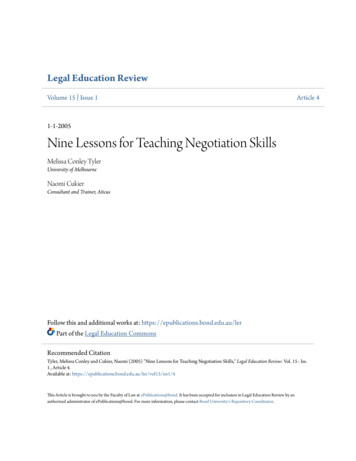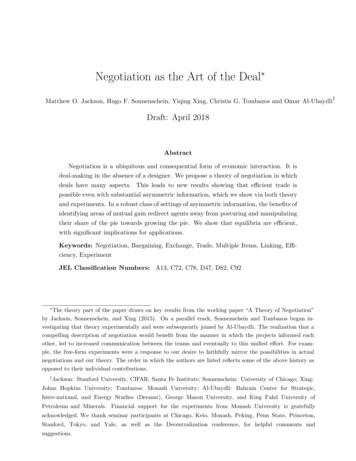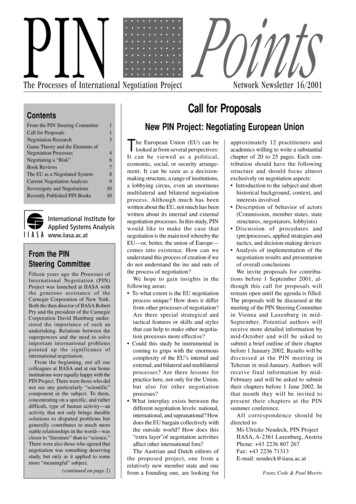
Transcription
Improve yournegotiation skillsSeptember 2010
TABLE OF CONTENTSI. INTRODUCTION . 3II. DEFINITION . 4III. PREPARATION OF THE NEGOTIATION . 51. General preparations for negotiation . 5a) Balance of power . 5b) Possible alliances and leverages . 5c) Time scales . 5d) Information available about them . 5e) The two main styles of negotiation . 5f) How to begin the negotiation? . 52. Specific preparation for negotiations. 6a) Your position . 6b) Their position . 6c) Your team . 6d) Their team . 6IV. The overall approach to negotiations . 91. Competitive/Adversarial Styles (Or Positional Bargaining). 92. Cooperative/Problem-Solving (Or Principled Bargaining) . 93. Can you be Principled while they are not? . 94. Bargaining style and settlement area. 10V. The negotiating process. 111. The opening stage. 112. The middle stage . 113. The closing stage . 114. What comes next?. 11VI. What skills do I need to be good at negotiating? . 121. Communication . 122. Problem Solving skills . 133. Representative skills . 134. Team work skills . 14VII. How to respond to tactics? . 15VIII. What makes a good negotiator? . 16
I. INTRODUCTIONNegotiation is a way for two or more parties who start from different positions to try to agree onsomething. Negotiation involves communication between the parties seeking to find somecommon ground. Sometimes exchanges occur that are described as negotiation but are notactually negotiation at all since one or both of the parties is not actually interested in finding ajointly agreed solution, or in changing their position. One side may be pretending to negotiatefor political or any of several other reasons, but not be prepared to offer anything. What leadsparticular sides to be willing to negotiate is something we will not cover. We will be looking atwhat happens when they are. Hopefully that will help you to be able to identify when the otherside is insincere.Many people have learned what they know of negotiation from doing it: experience is frequentlythe main training ground for many of us. However as with most important activities a goodappreciation of the factors involved means you are better able to be prepared and less likely tobe tricked into accepting something you do not want. You need to be clear about what you wantand the process by which you are going to get it. Mistakes can be very damaging.This means it is a stressful process. The negotiation can make decisions that affect manymembers for a long time to come. This means you carry a lot of responsibility both individuallyand collectively. Also the other side is likely to use a variety of tactics to distract you and get youto make mistakes – for example trying to make you confused, angry, intimidated, and/or unsureof your own knowledge. This can be in negotiation at all levels, and the thought that at the endof the negotiations the other side has somehow been more successful than you is always athreat. In truth you will never really know - even the fact that the other side will not know eitherdoes not lift the weight of your decisions.Labour/management relationships have become more complex in recent times: negotiations arenow rarely simple processes about simple issues. Sometimes formal procedures governparticular negotiation, and not knowing these would make it difficult for you to play a productiverole. Just relying on previous experience may not be enough because your previous experiencemay not have been like what you are about to be involved in. It is very likely those on the otherside of the negotiation table have experience and also some training in this area. To be able todeal with them effectively you need to be trained too – why let them have all the advantages?This brochure aims to get you to consider the following: What is involved in the process of negotiation How you currently approach negotiation How the other side might approach negotiation What you can do differentlyThere are no complete answers to the topic of negotiation: we cannot wave a magic wand andturn you into the best in the world. Importantly there is no –one-size-fits-all solution: every casemust be addressed individually on its merits. All this short brochure can do is to give you somepointers about how to look at your own practice and seek to learn from it. It can be hard workand it requires a degree of self honesty which can be demanding, but the potential gain is worthit.
4II. DEFINITIONWhat does it mean? To “negotiate”: To confer with view to finding terms of agreement. To arrange. To bringabout (desired result). “Negotiation”: The act or procedure of negotiatingAspects of Negotiation A process of exchangeA process of influencingA process of changing a relationshipA means of getting things achievedAn outcome-oriented doing processA process where sides with conflicting aims decide how they will cooperateCommunication with a specific purposeA group of skills which once identified can be learned through practiceScope:If you think through everything you are involved in during the day you are unlikely to identify asingle day involving no negotiation of any form: you are doing it continuously, even though youmay not be aware of it. We are all familiar with the times we sit across a table from our oppositenumbers but we should also be aware of the time we discuss with our colleagues who is goingto do what, in our union or in our workplaces. Negotiation might also happen when buying orselling [for example think about buying or selling a car or a house] or arranging delivery orcollection of things you have bought. It also happens at home. On reflection you may discoverthat you do most of your negotiation with your spouse, children, parents, and/or wider family.Family arrangements, children’s education, their welfare or dealing with particular members – allthese can take on the features of full-blown negotiations. You may also feel that at times theseare more complex than any negotiations you do elsewhere!
5III. PREPARATION OF THE NEGOTIATION1. General preparations for negotiatingPrior to the negotiations, it is important you develop a clear view about a range of issues thatshould then determine your choice of strategies.a) Balance of powerIn any negotiating situation, the power of each side influences the outcome. Employers who canswiftly move their activity to another country may be less dependent on you than the other wayaround. However, if you have high membership amongst highly skilled workers who are hard toreplace, your power is considerably bigger. Normally this will have its impact on what is realisticto expect from the negotiations. You must be honest in assessing your power and notoverestimate your own strength. – However, what you tell to the other side is a different thing.A way to assess your power is to compare the opponent’s cost to reject your offer with the costof accepting it: your power is the difference between both costs. Likewise, their power is yourcost to reject their offer compared with your cost to accept it. It shows that your power alwaysrelates to the other side: your power depends upon its impact on the opponent. It depends onhow they perceive your power and therefore you have to put yourself in their position to get agood idea of your own power. Be aware that this is no science but only an informed guess, somake sure your information is correct.b) Possible alliances and leveragesAnother aspect of the power relationship relates to any external relationship that may have animpact on the negotiations. Are other unions affected by the content of these negotiations? If so,can you gain their support, or at least come to an agreement they will not act in any way thatundermines your position? Similarly, is there any political or other support you can call upon tosupport your cause? Do you have for example contact with media that sympathise with you andcan offer positive media coverage? All this can provide additional pressure which enhancesyour power.c) Time scheduleHow long will it take to prepare the negotiations? How long will it take to negotiate? How longwill it take you to get the appropriate mandates? Are there any absolute deadlines? Once youhave identified all stages of the negotiation process, prepare a time schedule that marks thedifferent activities, dates and the responsible persons for each activity. Additionally, appointsomeone who is in charge to make sure that adequate progress is being made.d) Available information on the opponentHow sure are you about the opponent’s motivation and intentions? Is the general informationyou have about them sufficient, in a format you can use, ready to distribute to whoever needsit? Who will fill possible gaps in your data? What are useful sources? Do you have all necessaryinformation about your own position?e) The two main negotiation stylesWill the negotiation be a collaborative process [sometimes called cooperative bargaining, orwin/win] where both sides work together towards a commonly agreed outcome or will it be acompetitive process [sometimes called distributive bargaining, or win/lose] where both sidescompete and each side focuses on maximising their gains? This is likely to depend upon yourshared past, your relationship with the opponent, especially in the context of previousnegotiations. However, it is always advisable to keep both strategies in mind as things may notproceed as planned.f) How to start negotiating?Who is going to open the negotiations? When you are not clear on what their position is, or thinkit may have changed, it is advisable to let them start, otherwise you may be addressing outdated issues. If, however, you are clear about their position, you can get straight to the core and
6make your case, putting the focus on the main points according to your point of view. Youshould also consider the order in which the agenda items are to be handled: you may considerstarting with uncontroversial items, which could be easily resolved, and thus create a goodatmosphere to continue. Alternatively, you may feel there are real issues of difference and youneed to focus on these items immediately since it might take a lot of time to find a compromise.2. Specific preparations for negotiatingIt is sometimes said that failing to plan means planning to fail. This can also be said ofpreparation for negotiations. The time spent on preparing may often be more than that spent onthe negotiations themselves. As the stakes are high it is important that you prepareappropriately – it is your investment in the outcome.Additionally it is not something you do and then stick to it whatever. Any plan is only a plan andif it is not working then you should look again: flexibility and thinking on your feet are skills whichare especially important as things develop. At each new piece of information or where thingshave not gone according to plan you should regroup and reconsider: you may want to changeyour mind entirely about how best to proceed. The better prepared you are the more chanceyou have to change course when required.In general what you need to sort out in advance can be grouped in some broad categories.Exactly the details of your preparations will depend upon your circumstances and there may beitems not included in the following. Use this only as a guide and consult to identify whether thereare more boxes that need to be ticked in advance.a) Your position What you want Your opening position Your ‘resistance point’ The strengths and weaknesses of your case The arguments for your position What you can trade and what you want in exchangeb) Their position What they are likely to want The strengths and weaknesses of their position Their arguments for their casec) Your team Your individual skills and experience Your team roles Team signals Your ‘rules of engagement’ Who sits where?d) Their team What do we know about them? How are they likely to present themselves?Also you should consider the history of negotiations to date – how have they been and whatlessons can you draw.
7What you want The usual pattern in negotiations is that both sides start out with positions that they expect tosoften in order to reach an agreement. This means that the opening offer by both sides is notwhat either expects to achieve. If you were bargaining with a seller for a carpet you wouldn’tmake your first offer the maximum you intend to pay, otherwise there is nowhere for you tomove to. To pursue the analogy, your maximum is your ‘resistance point’, what you would preferto pay is your target, and what you first offer is your opening position.The difference between the opening position and the resistance point is known as thebargaining range: if you stick to your position, a settlement is only possible within these limits.Sometimes the negotiations have been called in response to some events involving demandsand it may be that some of this has been already chosen for you. You may be entering with aninitial position already publicly stated. That does not however mean that you cannot entershowing some degree of flexibility. Whether that is an appropriate step is for you to decide inthe full knowledge of the context. However some negotiators prefer to work backwards. In thisapproach the concept of BATNA may be useful.BATNA stands for the Best Alternative To a Negotiated Agreement. It refers to what is the bestyou might reasonable hope for if negotiations failed. If these discussions got nowhere, thenassuming business carries on, what is the feasible future, which is most favourable to your side.Whatever it is, you do not want to concede in negotiations to something which is worse: you donot want to agree to something which is worse than what you might get anyway. You mayconsider setting your bottom line at your BATNA or above1.Having established your resistance point by this or other means you need to identify your target:what do we want that is actually possible?The next step is to decide what your opening position is going to be.Your opening position is just as it were a finger in the wind: you are seeing what response itprovokes in them and it is a starting point, but not one which you expect to get. Do not set itvery close to what you actually want as this gives you little room for manoeuvre. Stating youropening position is often referred to as ‘anchoring’ – you are being attached to a point fromwhich you cannot subsequently move away.It is likely that the other side will likewise have a bargaining range. There is only a possibility ofsettlement if the two bargaining ranges overlap: this is called the potential settlement area.However, just because there is such an overlap, this does not necessarily mean an agreementwill be reached. Negotiators who are unskilled may not recognise or identify the potentialsettlement area and so may fail to reach an acceptable outcome. Additionally where there is anoverlap this does not mean any settlement which is achieved will be at the middle point, ie halfway between each of the resistance points. The skilled negotiators are those who seek to makethe outcome fall as close to their target as possible, to the detriment of the other side.Part of your preparation is to try to think yourself into your opponents’ position and guess whattheir bargaining range is. You will only ever know for sure [unless you have particularintelligence] what they have told you, and the last thing they said is the best information youhave as to their current position.Again it is important to note that your bargaining range also is a plan: depending upon theprogress of the negotiations you may think it wise to revise it.1After Fisher & Ury
8The force of your positionYou might wish to break your thoughts about this into three parts:Think about this in terms of what causes you to change your direction or position – the otherside is likely to be similarly motivated. Often you will do something if: Doing it has clear benefitsNot doing it has undesirable resultsIt really is the best course of actionThese can be characterised as the carrots, sticks, and strengths of your position. After statingwhat you want in negotiations, these are the reasons your demands should be conceded. Carrots:What carrots are on offer? Identify all the benefits that flow from your position. Obviously ithelps that these are presented in the most favourable light. Sticks:These cover what could happen if agreement is not reached – if you end in deadlock.Identify all the negative consequences and again these should be presented in the mostunfavourable light. Strengths:What evidence do you have for your position? Why is it a wise choice for them to agree withyou? In what way are they obliged to come along, and how can you show that really they donot have a choice? Sometimes looking at your position will highlight the need to obtainfurther information – eg some research is needed to track down the particular comparativedata. Ensure this is passed to appropriate support and/or delegated within your team.From this list, for each heading identify the 3 or 4 strongest points and have that to hand foryour negotiations. When stating these you will probably not wa
something. Negotiation involves communication between the parties seeking to find some common ground. Sometimes exchanges occur that are described as negotiation but are not actually negotiation at all since one or both of the parties is not actually interested in finding a jointly agreed solution, or in changing their position.










